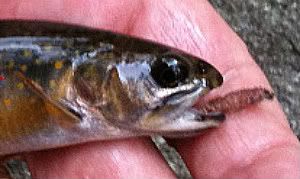Thank you all for sharing details of a fly with such historical reference. The fact that this yarn has all but disappeared is not surprising in considering the that it was obviously a blended wool, likely from several critters; maybe from numerous farms /areas of the country, and then for the military use of fixing socks, so many years ago!!
It tickles me, in that I, like so many, we will near place our lives on the line to protect the specific materials that go into some of our variations... the "Secret Fly".... that one that we know that no one else has because we don't share "IT".
I once fished with a river guide who I found out had such a secret fly, that only he "fished", kept so by not ever even allowing his "sports" to handle it! No one ever got closer the 8'-6" (rod length) to the fly. He would pull that small pocket sized box out towards the end of a "low count day" and save world peace!! But there were rules: He landed all fish by net, removing the fly to "check it" while handing you the net to look at your catch and release it. Then you fished on by him flipping the fly away fro you and into the water, thus protecting its full identity. With any gesture of intruding his "private fly", he removed it from your line, never to share with you again, even on a next booking! And, you thus forfeited opportunity to "catch big numbers", by his guiding!
We all know the greatness of our history; our secret fly variations; and the affects of confidence towards fishing. Collecting bits of history... those special bits of feather, books, equipment, tools, (Yes.... I have my "one and only" Herter's original, half hitch tool.... 1962.
https://i.etsystatic.com/11666628/r/il/ ... 5_k2zt.jpg ), There is still room for variation in tying an imitation of a crane fly larvae.
For those of us who lack a hidden card of 477 tucked away (oh.... special thanks to those who used a bit of the original stuff to tease the rest of us! That changing colors once wet, is still different in stained water vs tap water!!

), I give you the knowledge that "not all crane fly larvae look alike!!!" Our great friend over at Trout Nut.com and several other sites, have posted, some great pics:
http://www.troutnut.com/im_regspec/pict ... _large.jpg
https://www.northeastipm.org/neipm/asse ... -fly-1.jpg
https://www.northeastipm.org/neipm/asse ... -fly-2.jpg
https://diptera.info/forum/attachments/larvae_27mm.jpg
https://bugguide.net/images/cache/4HD/H ... ZL2ZSL.jpg
And where did the term "Four-eyes" come from???
https://diptera.info/forum/attachments/larvae_27.jpg
So you can see, they run the course of "shades of bug colors", blacks, gray, browns, and into olive/greens..... and who knew... some live in stream... others in earth.... and they all feed fish, buzz your face and scare some.... when turned to adults.
Back to the drawing board..... finding your local color critters, pass the yarn... and "Match the hatch".
Happy tying, tight lines, keep it all alive! History goes on!
P.S. Ray,
Keep an eye open for that "box of stuff" being adds to the "yard sale pile"..... or a bit of history could be lost. Thanks again for all you do around here to keep us tuning in!

